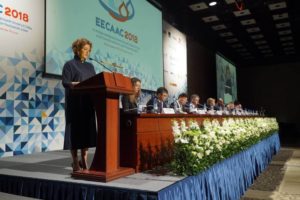
Author: Anastasia Petrova
Russia accounts for two-thirds of the new HIV cases in Europe and Central Asia. This is what the UNAIDS data show. One of the key factors contributing to the further spread of the epidemic is low treatment coverage: only one-third of people who need treatment get it. This fact, as well as other problems of the region, were discussed at the VI Eastern Europe and Central Asia AIDS Conference (EECAAC 2018) held in Moscow on 8 – 20 April 2018.
“What should be done to make sure that every HIV positive person has access to high-quality modern treatment from the day he is diagnosed with HIV in any place of our huge country? Maybe we should all – activists, business, government – honestly recognize that the AIDS war is lost, should join our efforts and reconsider where we are and where we go,” said Aleksandr Chebin, the activist of the Patient Control Movement, Yekaterinburg.
Patients demand treatment
“A special program was adopted in Russia to prevent the spread of the virus in the country, which allowed significantly increasing HIV/AIDS patients’ coverage with treatment services,” told Olga Golodets, Deputy Prime Minister of the Russian Federation at the EECAAC 2018 opening ceremony. However, experts say that the measures taken are not enough.
According to Vadim Pokrovskiy, Head of the Russian Federal AIDS Centre, only 35.5% of people living with HIV in Russia receive treatment. Even those who are registered in HIV care are not guaranteed treatment. In early 2018, fifteen regions of the country have reported stock-outs of antiretrovirals (ARVs).

Activists of the Patient Control Movement made attempts to voice this message at the opening ceremony. During the speech of Olga Golodets, people present at the ceremony stood up and took their coats off. Red letters on their snow-white T-shirts read STOP, STOCK-OUTS! This silent protest was a way for the patients to express their indignation with access to treatment in the country.
“Fight with HIV is a joint fight, which includes civil society and the volunteers who are now standing in front of us,” said the public official about the protest.
Disease of the system
According to experts from the International Treatment Preparedness Coalition in EECA (ITPCru), stock-outs are a systematic problem in Russia.
“The Ministry of Health announces tenders too late, and then the suppliers fail to supply drugs to the regions in time,” said Natalia Yegorova, Monitoring and Advocacy Officer, ITPCru.
Svetlana Prosvirina representing SIMONA+ project mentioned that according to the survey held by the patients’ community, 50% of patients of the AIDS centres faced problems when receiving their antiretroviral therapy (ART), such as stock-outs and frequent changes of treatment regimens.
“Apart from the stock-outs, we also identified other barriers in access to the health services: location of the AIDS centres, queues, long list of medical examinations to be completed before ART initiation (which is a significant barrier for injecting drug users), long-term before treatment start – 1 to 3 months, and health care system-related problems, such as stock-outs of ARV drugs and diagnostic tools,” told Svetlana.
Tim Martino, Deputy Director of UNAIDS called Russia to adopt the international ‘test and treat’ strategy. This approach stipulates treatment initiation not waiting for the immune status going down. Such strategy proved effective in the African states. However, it is still ignored in Russia.

Timofey Nizhegorodtsev, expert of the Russian Federal Antimonopoly Service delivered a speech at the session “Strategies to Enhance Access to ARVT and Drugs to Treat Comorbidities in the EECA in the Light of Current State of Affairs.”
“Currently, a draft law on public health is prepared, which will allow local producers to manufacture the required drugs at affordable prices,” he said
Price reduction is the key
Only a sharp price reduction will make it possible to provide all people in need with treatment in the country, experts say. Vinay P. Saldanha, UNAIDS Regional Director for Eastern Europe & Central Asia explained that to cover all patients with treatment the price of a yearly course per patient should not exceed USD 100.
“Only in this case, the Russian Federation has a chance to achieve the 90-90-90 targets and meet the commitment to end the HIV epidemic by 2030,” pointed out Mr. Saldanha.
The key results of EECAAC 2018, as well as the actions to be taken, are included to the Final Statement of the VI Conference. The document is currently to be adopted by the Russian Federal Service for Surveillance on Consumer Rights Protection and Human Well-being (Rospotrebnadzor) and will be published before the end of April.



